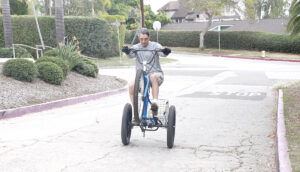 I received a call to appraise vintage French Bicycle advertising posters, so I headed to my client’s huge garage in Ojai. Not only did I see wonderful early 1900s lithographic poster art, but also a garage packed with bike tools, machines, bike parts, motors, welding gear, vintage red metal cabinets, and Gerstner wooden toolboxes.
I received a call to appraise vintage French Bicycle advertising posters, so I headed to my client’s huge garage in Ojai. Not only did I see wonderful early 1900s lithographic poster art, but also a garage packed with bike tools, machines, bike parts, motors, welding gear, vintage red metal cabinets, and Gerstner wooden toolboxes.
Reggae music blasted, and out from under the tools emerged an inventor with protective googles. He showed me his latest project, an invention to “convert” any two-wheel BMX framed bike to a wheelie tricycle. For this he developed a totally new style of gearing, braking, and welded attachments. He said he was installing housings for an electric motor and a carry-platform to the rear that covered the trike’s back two balloon tires.
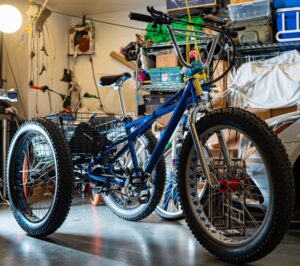 I asked, “What made you begin this invention? Why now? What inspired the creation of yet another trike?”
I asked, “What made you begin this invention? Why now? What inspired the creation of yet another trike?”
“Why did other inventors invent their trikes when they did?” He said. “I just felt like NOW was the right time to put three wheels where there was once only two!”
I promised to write about the spirit of invention in my next newsletter. Without a universe of invented OBJECTS our material culture wouldn’t exist. That means tools, weapons, art, furniture, clothing, machines, gadgets, and buildings—all examples of material culture. Any ponderable object invented by humans qualifies as material culture. If we became extinct, the nonmaterial elements of our culture would disappear, BUT NOT the THINGS! Do the things we create shape us—or do we shape those things?
This newsletter defines five ‘spurs’ to invention as exemplified in the creation of the tricycle. Since humans first traveled on three wheels (1600s) the world has used three wheels for transport, mobility, commerce, personal conquest over disability, and sport. As four year-olds, we learned to move on wheels on our first white rubber handle-gripped red trike.
First Invention: What’s that? The mother of invention?
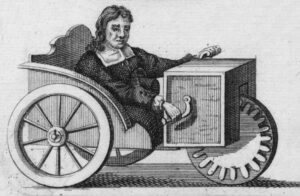 Out of necessity in the mid-1600s a disabled (old word: “lame”) German clockmaker, Steffen Farffler, wanted to get around his village. So he made a box with a seat inside propelled on three wheels through hand cranks and gears. This became the first DELTA trike, a vehicle with one front wheel and two in the rear with the rider above the rear wheels.
Out of necessity in the mid-1600s a disabled (old word: “lame”) German clockmaker, Steffen Farffler, wanted to get around his village. So he made a box with a seat inside propelled on three wheels through hand cranks and gears. This became the first DELTA trike, a vehicle with one front wheel and two in the rear with the rider above the rear wheels.
Second Invention: Can’t Pay That Much. What Can I Invent?
Out of frugality two tradespeople took to playing with three wheels in Paris in the year the French Revolution began. Horses were in short supply, and they couldn’t afford a horse and carriage anyway. They put pedals on the front wheel. The vehicle we give to our kids on their fourth birthday is this very same vehicle except for SIZE.
For speed, the wheels of this 1789 trike were huge. However, the same problems you experienced when you learned to ride your trike at four years-old, the invertors, Blanchard and Maguier, experienced as well. The degree of the turn, limited by the location of one’s feet on the front wheel, made steering difficult. The rider’s weight wasn’t well distributed due to the height and length of the vehicle. Tips happened often. Forward direction required coordination of hands, feet, and legs, and not every common person was so gifted. The tallest tire, four to five feet, in the front generated great speed but was hard to control between the legs. Riding meant hard work. Yet this style made its way all over the world and was still used well into the late 19th century.
Third Invention: I Can Do It Better!
 In the mid to late 19th century the proper society of England developed a ‘fashionable craze’ for tricycles, seen as “not as scandalous” as two wheeled bikes. Ladies alighted more graciously. Men didn’t look as unseemly in the more upright seated position required by a trike as opposed to a bike. Clothing for both men and women guaranteed disasters on a bike, but not so commonly on a trike. Cumbersome skirts, for example, seemed less blowsy in the limited ‘wind’ a trike generated.
In the mid to late 19th century the proper society of England developed a ‘fashionable craze’ for tricycles, seen as “not as scandalous” as two wheeled bikes. Ladies alighted more graciously. Men didn’t look as unseemly in the more upright seated position required by a trike as opposed to a bike. Clothing for both men and women guaranteed disasters on a bike, but not so commonly on a trike. Cumbersome skirts, for example, seemed less blowsy in the limited ‘wind’ a trike generated.
One town in England, Coventry, became the center of invention. One inventor, James Starley, outdid himself in numerous inventions of the three wheeled kind. In a town where many inventors competed to build a better trike, Starley became hands-down the trike king. He invented the Tadpole trike with two wheels in front and one rear wheel for steering. Then he did himself one up. In 1876 he invented a pedal trike with two wheels on ONE SIDE and one wheel on the other. This MAIN wheel, the driving wheel, was powered by hand levels, not pedals. Then he played around with an inline trike with three wheels in a ROW with only two wheels that “drove” the trike. Starley’s piece de resistance was the rotary chain drive trike.
Fourth Invention: Overcoming Adversity
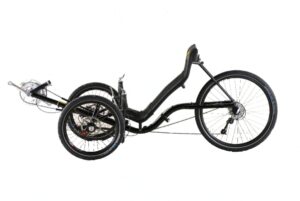 In the early 20th century a woman invented the hand and foot trike. This Tadpole style trike became necessary because of the of loss of mobility due to spinal injury. The rider’s shifting body weight changed the direction of the trike. This depended on the use of either hand or foot, because she adapted the trike so either hand or foot rotated the rear “driving” wheel. For those of us a little older than we used to be, a version of this invention is the recumbent tadpole or reverse trike, with two steered wheels in the front and a low seat. It’s a lighter trike, and less tippy than an upright trike because of its low center of gravity and great aerodynamics.
In the early 20th century a woman invented the hand and foot trike. This Tadpole style trike became necessary because of the of loss of mobility due to spinal injury. The rider’s shifting body weight changed the direction of the trike. This depended on the use of either hand or foot, because she adapted the trike so either hand or foot rotated the rear “driving” wheel. For those of us a little older than we used to be, a version of this invention is the recumbent tadpole or reverse trike, with two steered wheels in the front and a low seat. It’s a lighter trike, and less tippy than an upright trike because of its low center of gravity and great aerodynamics.
Fifth Invention: Because I LOVE MONEY I WILL DO THIS!
Commerce drove many trike inventions and uses. Urban delivery of objects and food, warehouse stocking trikes, vending carts, job site carts, and rickshaws are seen all over the world in the tadpole style with a carry-platform over the front two wheels. These necessitated the invention of a heavy frame, robust drive train, low gearing, and varieties of platforms and container boxes.
Sixth Invention: Out of LOVE I INVENT
In 1930 a dad named Charles Mochet in France wanted to ride with his son. So he built a small four wheeled bike called a ‘velo car’ with two or more seats. Out of this invention came the velomobile with three wheels and a covering of cloth or fiberglass.
Seventh Invention; Because of the HIPNESS Factor, Let’s GO
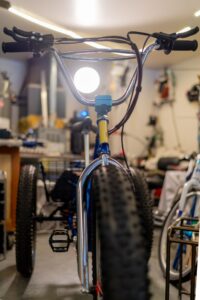 Cast yourself back to the oil crisis of the 1970s and the growing concern over ecology. EVI of Sterling Heights MI invented a two person pedal powered trike called a ‘People Powered Vehicle.’ On this trike with two seats, either the driver or passenger, or BOTH pedaled. Space age capsules formed the hood of the vehicle, or sometimes we see the more ‘traditional’ covering like a surrey with the fringe on the top.
Cast yourself back to the oil crisis of the 1970s and the growing concern over ecology. EVI of Sterling Heights MI invented a two person pedal powered trike called a ‘People Powered Vehicle.’ On this trike with two seats, either the driver or passenger, or BOTH pedaled. Space age capsules formed the hood of the vehicle, or sometimes we see the more ‘traditional’ covering like a surrey with the fringe on the top.
These examples show HOW inventions happen. How about YOURS?